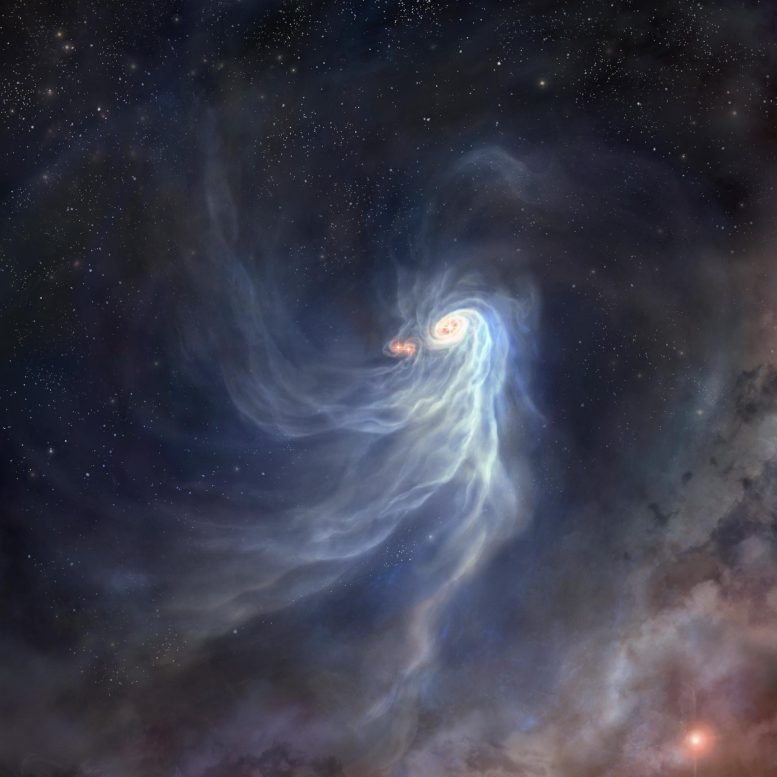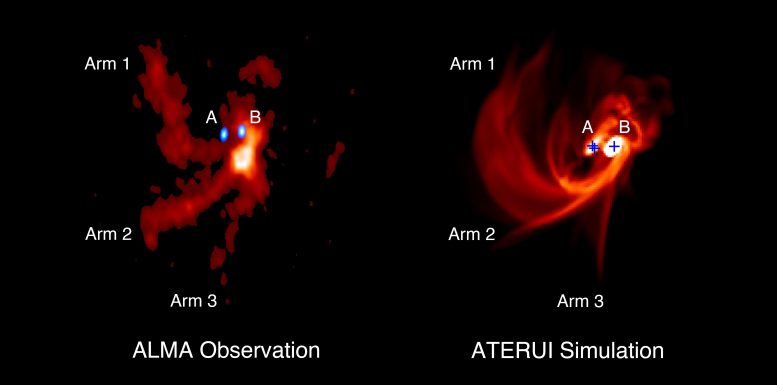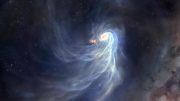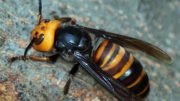
Artist’s impression of the triple protostars, IRAS 04239+2436. New research utilizing both observations and simulations has shed light on the formation of multi-star systems. Credit: ALMA (ESO/NAOJ/NRAO)
Researchers using ALMA and advanced simulations have clarified the formation of multi-star systems, identifying and explaining the role of “streamers” feeding developing protostars.
New observations and simulations of three spiral arms of gas-feeding material to three protostars forming in a trinary system have clarified the formation of multi-star systems.
Most stars with a mass similar to the Sun form in multi-star systems together with other stars. So an understanding of multi-star system formation is important to an overall theory of star formation. However, the complexity and lack of high-resolution, high-sensitivity data left astronomers uncertain about the formation scenario. In particular, recent observations of protostars often reported structures called “streamers” of gas flows toward the protostars, but it has been unclear how these streamers form.

Gas distribution around the trinary protostars IRAS 04239+2436, (left) ALMA observations of SO emissions, and (right) as reproduced by the numerical simulation on the supercomputer ATERUI. In the left panel, protostars A and B, shown in blue, indicate the radio waves from the dust around the protostars. Within protostar A, two unresolved protostars are thought to exist. In the right panel, the locations of the three protostars are shown by the blue crosses. Credit: ALMA (ESO/NAOJ/NRAO), J.-E. Lee et al.
An international team led by Jeong-Eun Lee, a professor at Seoul National University, used the Atacama Large Millimeter/submillimeter Array (ALMA) to observe the trinary protostar system IRAS 04239+2436 located 460 light-years away in the constellation Taurus. The team found that emissions from sulfur monoxide (SO) molecules trace three spiral arms around the three protostars forming in the system.
Comparison with simulations led by Tomoaki Matsumoto, a professor at Hosei University using the supercomputers “ATERUI” and “ATERUI II” in the Center for Computational Astrophysics at the National Astronomical Observatory of Japan (NAOJ) indicate that the three spiral arms are streamers feeding material to the three protostars.
This combination of observations and simulations has revealed, for the first time, how the streamers are created and contribute to the growth of the protostars at the center.
A simulation of multiple star formation by the supercomputer “ATERUI”. The movie shows that multiple protostars are born in a filamentary turbulent gas cloud, and they excite spiral arms and disturb the surrounding gas as they orbit. Credit: Tomoaki Matsumoto, Takaaki Takeda, 4D2U Project, NAOJ
For more on this research:
- Protostars in Triple Formation Illuminate Stellar Feeding Mechanisms
- Astronomers Reveal Triple Baby Star Feeding Frenzy
Reference: “Triple spiral arms of a triple protostar system imaged in molecular lines” by Jeong-Eun Lee, Tomoaki Matsumoto, Hyun-Jeong Kim, Seokho Lee, Daniel Harsono, Jaehan Bae, Neal J. Evans II, Shu-ichiro Inutsuka, Minho Choi, Ken’ichi Tatematsu, Jae-Joon Lee and Daniel Jaffe, 4 August 2023, The Astrophysical Journal.
DOI: 10.3847/1538-4357/acdd5b









Be the first to comment on "Spiraling Into Stardom: The Role of Gas Streamers in Multi-Star Births"